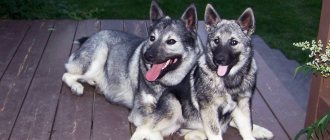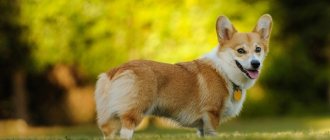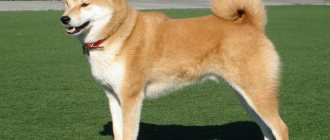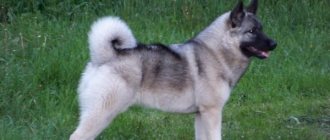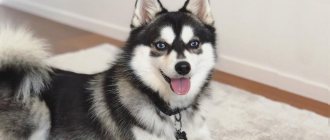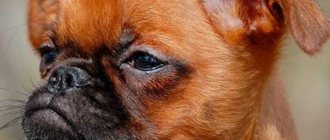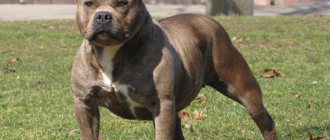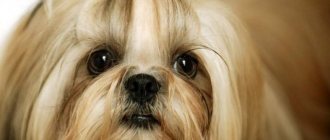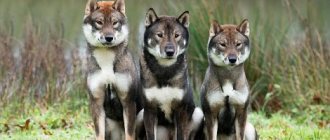Having become a national treasure and one of the symbols of Norway, a true northern treasure, the Norwegian Laika, or Elkhound, embodies the idea of an intelligent, fearless, hardy, almost ideal hunting dog. Everything about it deserves admiration and respect: the centuries-old history of the breed, rare working qualities, extraordinary devotion to people.
Norwegian Husky
History of the breed
Gray Elkhounds appeared many centuries ago. The breed was officially registered when a new variety was developed - the Norwegian Black Elkhound. The event occurred in 1901 and both varieties were recognized.
Since time immemorial, these dogs have been considered the national Norwegian dogs. They were loyal friends, but were still made to help hunt large game such as elk and bear. The extraordinary flair of the northern dog, its endurance and passion for the hunt certainly led to the capture of prey, and the hunter never returned from the hunt empty-handed.
Today, the Norwegian Elkhound is also popular among hunters. With its help, you can track and catch lynx, wolves and a variety of small game. But not only avid hunters buy puppies. This breed is truly a family breed. The Elkhound is kind, obedient, intelligent and affectionate, gets along well with children, allows them to play with him and behaves more than carefully when playing. He will never, even accidentally, bite a child or attack a pet.
General conclusion about the Norwegian Black Elkhound
The Norwegian Black Husky is suitable for hunters living in rural areas, as it can be kept well in an enclosure. It is strictly forbidden to keep him on a chain: the dog’s psyche may deteriorate. Outside the city, it is possible to walk your pet for a long time, which is beneficial for its physical health. Easy to train and remembers commands well. It may well become an indispensable assistant.
Previous entry Hunting marten: methods, secrets, techniques
Next entry Instead of a son
Appearance description
As a rule, the Elkhound is quite large, it grows up to 50 centimeters at the withers, it can weigh from 20 to 25 kilograms, girls are slightly smaller. The dog is proportionally built and has a very similar appearance to the husky, which is why it is also called that. The muzzle is quite cute, without rough features. The head is rounded and has triangular ears that are very movable. The paws are powerful, with fairly wide but neat feet, which allow them to easily overcome snow cover and long distances. The chest is wide, the tail is held in a ring, like all huskies.
Care and hygiene
Elkhounds are quite clean, so grooming the dogs is not difficult. Their coat has two layers - a guard hair of a hard texture and a softer, but rather dense fleecy undercoat. Grooming usually consists of weekly combing and brushing. During periods of seasonal molting, the procedure is carried out more often to avoid the formation of tangles. In spring and summer, after each walk, it is necessary to examine the dog for ticks.
Items for combing wool
An Elkhound should only be bathed when it is very heavily or extensively soiled. In general, the coat of the Norwegian Husky cleans itself well when walking through tall, dewy grass or deep snow.
Important! The advantage and peculiarity of the Elkhound is that the dog does not have the characteristic unpleasant dog odor.
Eyes and ears are cleaned as needed. In the absence of dark or cloudy discharge from the eyes and plaque on the inner surface of the ears, caring for these areas boils down to wiping them once a week with a special zoo lotion or a damp cloth.
Clear eyes, clean ears, shiny coat - indicators of good health of the Elkhound
Coat and color
When describing external data, I would like to pay special attention to the quality of the coat and color. The Norwegian Elkhound is a northern dog, and nature has endowed it with coarse hair and a thick silver undercoat that will protect it from any bad weather. The breed's neck is decorated with a luxurious collar.
As we wrote earlier, today there are two known breeds of Norwegian Elkhound - the black moose husky and the gray moose husky. They are similar in temperament, but differ in color, coat and slightly in physical characteristics. The black Elkhound's coat is rougher and shorter, while the gray Elkhound's is softer and longer. Both huskies may have white markings, but they are still not welcome. The black Elkhound is more mobile, active and flexible, the gray one is a little clumsy at first glance, but this is far from the case. He is calmer and more reasonable, carefully considering his every action and movement.
Health and illness
Norwegian elk huskies have good health and strong immunity. Some individuals have a predisposition to a number of diseases. Among them:
- progressive retinal atrophy;
- epilepsy;
- cataract;
- kidney cysts (usually occurs in older dogs).
Like most large breeds, moose huskies are at risk of developing hip dysplasia. The pathology appears after six months (during the period of intensive growth of the pet). It is characterized by a genetically determined disorder in the formation of joint tissue with subsequent loss of limb functionality.
Attention: to avoid problems, you need to ask his parents before purchasing a puppy.
The first signs of dysplasia are:
- difficulty getting up on your paws after sleep;
- fast fatiguability;
- lameness during exercise;
- decreased activity;
- aggression, whining during palpation of the limb.
If the disease is noticed early, it can be treated with conservative methods. In other cases, the animal undergoes joint replacement surgery.
Lifespan
Elkhounds live on average 12-16 years. Some individuals die at the age of 18 years or older. In many ways, the life expectancy of a Norwegian elk husky depends on the quality of feeding and care for the dog.
It is important to monitor changes in your pet’s health; at the first signs of illness, do not self-medicate, but contact a veterinarian. In order to promptly notice possible deviations, it is necessary to undergo an annual preventive examination. Strictly follow the schedule of vaccinations and antiparasitic treatments.
Psychological picture
The Norwegian Elkhound is a fairly independent and independent creature. He himself knows the rules of behavior, he thinks about his actions, the conditions of the northern country have taught him to do this. He is very friendly, active, obedient and affectionate. He loves it when his owner praises him and is very kind to all family members. He is intolerant of pets and is unlikely to make friends with them, but still he will not touch or offend them. He will be an excellent companion in children's games. The Norwegian Elkhound loves children very much.
He is wary of strangers, but does not show direct aggression until there is a need to protect his own.
From an early age, the Elkhound needs affection, strict, but careful and kind education. In return, he will give his love, help and protection.
The active northern dog needs constant physical activity, so it is not suitable for lazy people and couch potatoes. With such a friend you need to walk a lot and for a long time. Hiking through the forest or just across a large area is suitable. If you like to ride a bike, feel free to take your dog with you, he will run after you with great pleasure.
Laika from Norway and its history
If we could ask the Vikings or the people who lived in tribes in caves, they would tell us that even then the ancestors of the Norwegian Elkhounds were nearby.
The skeleton of such a dog was found by researchers in the Vist Cave in Norway. During excavations of Viking burials dating back to the 8th century, the remains of huskies were also found. The Laika from the North Country was nicknamed the Elk Dog due to the fact that elk were the breed's hunting specialty. Later, cattle breeders and shepherds also began to use Elkhounds as guard and guard animals.
In 1877, Norwegian hunters introduced dog handlers to huskies, whose exterior had been formed in natural conditions over centuries.
The Swedes and Norwegians were the first to recognize the breed, and after them the Elkhounds received recognition in other cynological associations. Today, in addition to the homeland of huskies, their breeding purity is maintained in the USA, Canada and Great Britain.
Training
The Norwegian Elkhound should be trained from an early age, because when it grows up, it will turn into an independent dog. To train teams, they need a dominant owner who will strictly, consistently and fairly train and give knowledge about the necessary disciplines and rules of behavior. The elk husky is very smart and quickly learns commands. She will try, just don’t forget to praise her. The Norwegian Elkhound is demanding of praise for its merits, so if it does not receive kind words and encouragement, it will answer you in kind.
Pros and cons of the breed
Norwegian Hunters, like representatives of any other breed, have positive and negative sides that must be taken into account when buying a pet.
Among the advantages:
- expressive appearance;
- good health;
- devotion to the owner;
- developed working qualities;
- friendly attitude towards children;
- developed intelligence;
- ease of care.
The disadvantages of moose huskies include:
- stubbornness;
- heavy shedding;
- tendency to joint diseases;
- undesirability of living in an apartment;
- desire for dominance;
- excessive activity;
- the need for a long walk.
For those wishing to engage in breeding, an additional disadvantage is the low prevalence of dogs in the CIS. Finding a mating partner will not be easy.
Nutrition
If you decide to feed your dog homemade, natural food, you must remember that the dog is a carnivore, and its daily diet should contain at least thirty percent meat. The Norwegian Elkhound is an active breed, it spends a lot of energy, so we increase the amount of meat to fifty percent. The rest of the food is porridge with water made from buckwheat, oatmeal, millet and rice. Sometimes you can give rolled oats. Avoid barley completely, as it is practically indigestible, and peas, because they cause bloating. Boiled and raw vegetables are required for nutrition every day.
Milk should not be given as it can cause diarrhea. Give low-fat cottage cheese, low-fat kefir or yogurt. Under no circumstances should you pamper your dog with buns or other flour products; they will cause your pet to gain a lot of weight. Avoid sweet treats to avoid damaging your teeth; it will be healthier for them to get a tasty bone.
Dry food is perfect, but only premium or super premium; economy food is practically devoid of much-needed meat. If you choose this diet, then do not forget to constantly fill the dog’s bowl with water.
Activity
The Norwegian Elkhound is not a breed that is suitable for living in an apartment. She needs physical activity and a large space, so it is best if the animal has a large fenced yard at its disposal. The dog will feel great on a farm, where he will have a lot of familiar work.
The Elkhound is a wonderful companion. Dogs of this breed have proven themselves well in protection, they are excellent watchmen, they herd livestock very skillfully, and when harnessed to a sleigh, they can transport loads.
Due to the thick, fleecy undercoat, the dog can hardly tolerate the heat, and on frosty winter days and even in inclement and rainy weather, it feels very comfortable. On summer days, the Elkhound loves to swim and hides from the sun's rays in a shady place.
Norwegian Elkhound puppies
The offspring is born completely black, but over time it becomes lighter, having shed several times (of course, if it is not a black Elkhound). As puppies they are very plush and cute. A good puppy costs about 65,000 rubles.
If you are purchasing such a dog, contact an experienced breeder. The enclosures where dogs are kept should be dry and there should be no unpleasant odor. When choosing a pet, be guided by the fact that the puppy is active and mobile, makes contact, and plays with his brothers.
An experienced breeder will suggest the best “baby” from the entire litter. He will explain how to properly maintain and raise, feed and train. Usually the breeder offers assistance in training at first. If you have the opportunity, do not refuse such services.
How to choose a puppy
Buying a Norwegian elk husky in Russia is not easy, since the breed is not very popular and there are few nurseries. You may have to wait in line for a puppy. A purebred baby costs on average 500-700
Attention: purchasing a pet without documents based on an advertisement on the Internet may result in receiving a large, non-viable individual!
The breeder must present to the potential buyer the pedigrees of the baby's parents, the results of a complete veterinary examination of both the male and the female. With the puppy, the new owner is given a birth certificate (which can later be replaced with a pedigree), a veterinary passport with notes on the first vaccinations, and deworming procedures.
The dogs also need to be examined. If a pet is purchased abroad, this can be done via video call. Healthy puppies have the following characteristics:
- shiny coat without tangles or protruding tufts;
- the anus is clean;
- nose, ears, eyes without discharge;
- a lively, curious look;
- the tummy is well-fed, but not bloated (this is a sign of infestation);
- correct bite;
- straight limbs.
The small Elkhound has the following breed characteristics:
- short, proportional body;
- tail set high, curled over the back;
- gray-black color.
The puppies are active, curious, not afraid of new people, and do not aggression. They happily run out to meet each other and play with their brothers and sisters. You need to pay attention to the entire litter. If among the puppies there are clearly sick ones who are lagging behind in development, it is better to refuse the purchase. A number of dangerous infections may appear later.
Character
Despite the harshness of the cold regions of origin, the Norwegian Elkhound is a very affectionate and sensitive dog. At the same time, he is quite independent and independent; in hunting he shows independence and determination. He is characterized by detachment and a desire to manipulate the owner. In the absence of proper upbringing, Norwegian Elkhound dogs can cause inconvenience to humans: they can be difficult to control, disobedient, independent, and react aggressively to other animals.
It is not recommended to have such a dog in families with small children, as it can perceive babies as prey and harm them. But they will get along well with adult children and will even be able to protect them if necessary. In general, Norwegians get along well with other animals, provided they are in the family from infancy.
They have good watchdog qualities, as they react quite warily, and sometimes even hostilely, to the unusual actions of a stranger. When danger arises, they emit a ringing bark, characteristic of this breed, which can serve as a kind of danger signal.
Dossier
Adult height: 48-54 cm. Weight: 16-24 kg. Characteristic color: gray, black. Coat length: short on the head, limbs, long on the neck, legs and lower abdomen. Life expectancy: 13-16 years. Advantages: security and hunting abilities. Difficulties: independence, complex character. Average price: $450-600. Classification: medium size, hunting, pet.
Distinctive features
The Norwegian Shepherd must meet the following FCI standards:
- The head is wedge-shaped, with pronounced contours, not heavy . The skull appears flat, the line parallel to the muzzle. The stop is clear.
- Scissor bite , straight bite is considered a defect. Overshot and undershot are disqualifying faults.
- The lobe is exclusively black. A pink or liver tint is a significant drawback.
- The eyes have an oval shape, the iris is as dark as possible. The eyelids are only black. Eye color that is too light and their protrusion is considered a defect.
- The neck is set high and has no dewlap.
- The ears are fully erect; any other position is grounds for disqualification. The tips are pointed.
- The tail is a dense ring, lies on the back, slightly thrown to the side. Weak twist or drooping is a fault.
- The body is compact; a defect is considered to be too light a build or, conversely, heavy and rough. Deviation from the standard in height is allowed no more than 1 cm below the border or 2 cm above. The back line is straight and short.
- Legs are straight and straight. The elbows are not turned out and are adjacent to the body. The legs and thighs are muscular, the angulation of the hind legs should not be too pronounced.
- The movements are light, the back always remains straight during the move. Short steps are considered disadvantages.
- The coat is two-layered. The upper level is thick and coarse hair, the lower level is soft. The coat is straight, very short on the head and front of the body, slightly more pronounced on the collar of the neck, chest area, tail and feathering of the hind legs. Long hair is a defect.
- The color is biscuit (from pale to golden red) or black. White spots are allowed, but minimal and small in size. For a light tone, a mask on the face and dark tips of the coat are allowed.
